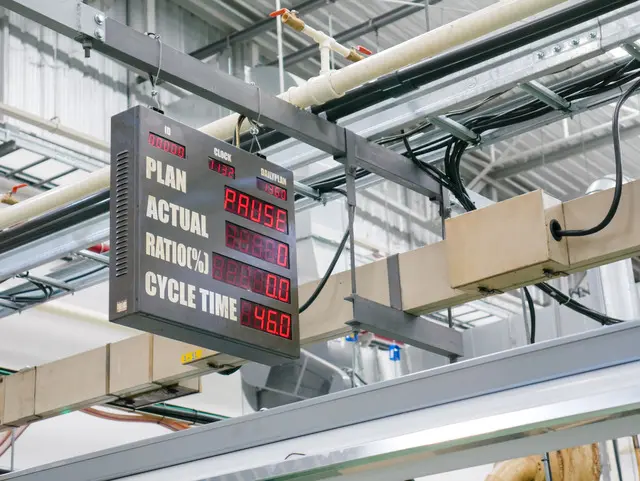Revolutionizing Energy Management in Manufacturing with Intelligent Automation
In the competitive landscape of manufacturing, optimizing energy consumption is crucial for reducing costs and increasing efficiency. Energy Management Automation empowers manufacturers to streamline energy monitoring and optimization processes, leveraging the power of Python, AI, and cloud-based solutions. By embracing Energy Management Automation, manufacturers can gain real-time visibility into their energy consumption, identify inefficiencies, and implement targeted measures to reduce waste. This intelligent approach humanizes the energy management process, making it more efficient, accurate, and responsive to the dynamic needs of the manufacturing industry.

Harnessing the Power of Python, AI, and the Cloud for Energy Management Automation
Python, with its vast library of tools and frameworks, plays a pivotal role in Energy Management Automation. Unattended bots developed using Python can seamlessly automate repetitive tasks such as data collection, analysis, and reporting. These bots tirelessly monitor energy consumption patterns, identify anomalies, and trigger alerts, ensuring proactive energy management.
Attended bots further enhance automation capabilities, providing real-time assistance to human operators. Built with Python, these bots offer a high degree of customization, enabling manufacturers to tailor automation to their specific needs. They can assist operators with complex tasks such as optimizing machine usage, adjusting production schedules, and identifying energy-saving opportunities.
Cloud platforms, with their unparalleled scalability and feature-rich offerings, surpass traditional RPA/workflow tools in automation orchestration. They provide a comprehensive suite of services, including data storage, analytics, and machine learning capabilities, empowering manufacturers to harness the full potential of Energy Management Automation.
AI plays a transformative role in enhancing the accuracy and efficiency of automation. Techniques like image recognition can automate the monitoring of energy meters and gauges, while natural language processing (NLP) enables bots to comprehend and respond to complex instructions. Generative AI can generate optimized energy management strategies based on historical data and real-time conditions.
By leveraging the combined power of Python, AI, and the cloud, manufacturers can unlock the full potential of Energy Management Automation, revolutionizing their energy management practices and driving significant cost savings and efficiency improvements.

Building a Robust Energy Management Automation with Python and the Cloud
The journey to successful Energy Management Automation involves a systematic approach, breaking down the process into manageable sub-processes:
- Data Collection: Python scripts can be deployed to collect data from sensors, meters, and other sources. Cloud platforms provide secure storage and management of this data.
- Data Analysis: Python’s powerful data analysis libraries enable the identification of patterns, trends, and anomalies in energy consumption. Cloud platforms offer scalable computing resources for complex analysis.
- Optimization: AI algorithms, integrated with Python and the cloud, optimize energy usage based on real-time data and historical patterns.
- Reporting and Alerts: Python scripts generate customized reports and trigger alerts based on predefined thresholds, ensuring timely and actionable insights.
Data security and compliance are paramount in manufacturing. Python and cloud platforms provide robust security measures, encryption protocols, and compliance certifications to safeguard sensitive data.
Compared to no-code RPA/workflow tools, Python offers greater flexibility, customization, and scalability. It empowers manufacturers to tailor automation to their unique needs and integrate with existing systems. RPA tools often lack the sophistication to handle complex energy management scenarios.
Algorythum’s unique approach stems from witnessing client dissatisfaction with off-the-shelf automation platforms. Pre-built RPA tools can be limiting, inflexible, and fail to address the specific challenges of Energy Management Automation. Python’s open-source nature, combined with the power of the cloud, provides a far more comprehensive and effective solution.

The Future of Energy Management Automation
The future of Energy Management Automation holds exciting possibilities to further enhance energy efficiency and sustainability in manufacturing:
- Integration with IoT and Edge Computing: Connecting sensors and devices to the cloud via IoT gateways will enable real-time monitoring and control of energy consumption at the edge.
- Predictive Analytics and Machine Learning: Advanced algorithms will leverage historical data and real-time insights to predict energy consumption patterns and optimize usage even more effectively.
- Blockchain for Secure Data Management: Blockchain technology can provide a secure and transparent platform for sharing energy data among multiple stakeholders.
We encourage readers to subscribe to our platform for the latest advancements in Energy Management Automation and other industry-specific automation solutions. Contact our team today for a free feasibility and cost estimate tailored to your unique requirements. Together, we can unlock the full potential of automation and drive your manufacturing operations towards a sustainable and profitable future.

Algorythum – Your Partner in Automations and Beyond
At Algorythum, we specialize in crafting custom RPA solutions with Python, specifically tailored to your industry. We break free from the limitations of off-the-shelf tools, offering:
- A team of Automation & DevSecOps Experts: Deeply experienced in building scalable and efficient automation solutions for various businesses in all industries.
- Reduced Automation Maintenance Costs: Our code is clear, maintainable, and minimizes future upkeep expenses (up to 90% reduction compared to platforms).
- Future-Proof Solutions: You own the code, ensuring flexibility and adaptability as your processes and regulations evolve.









